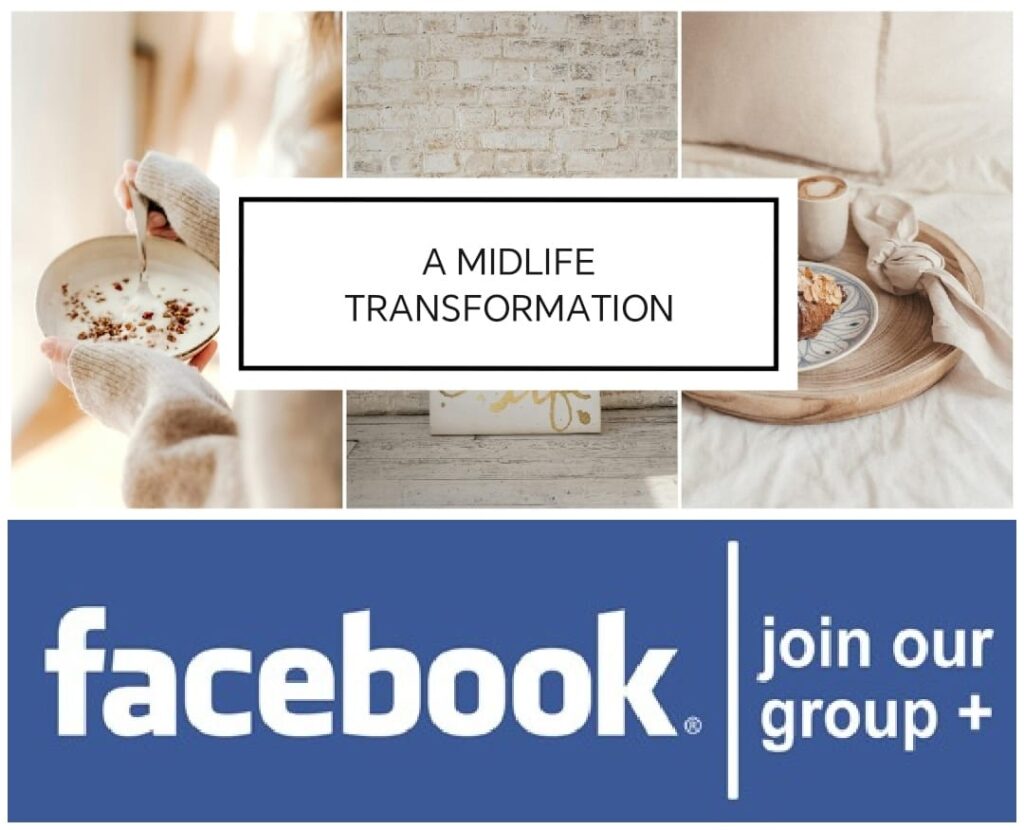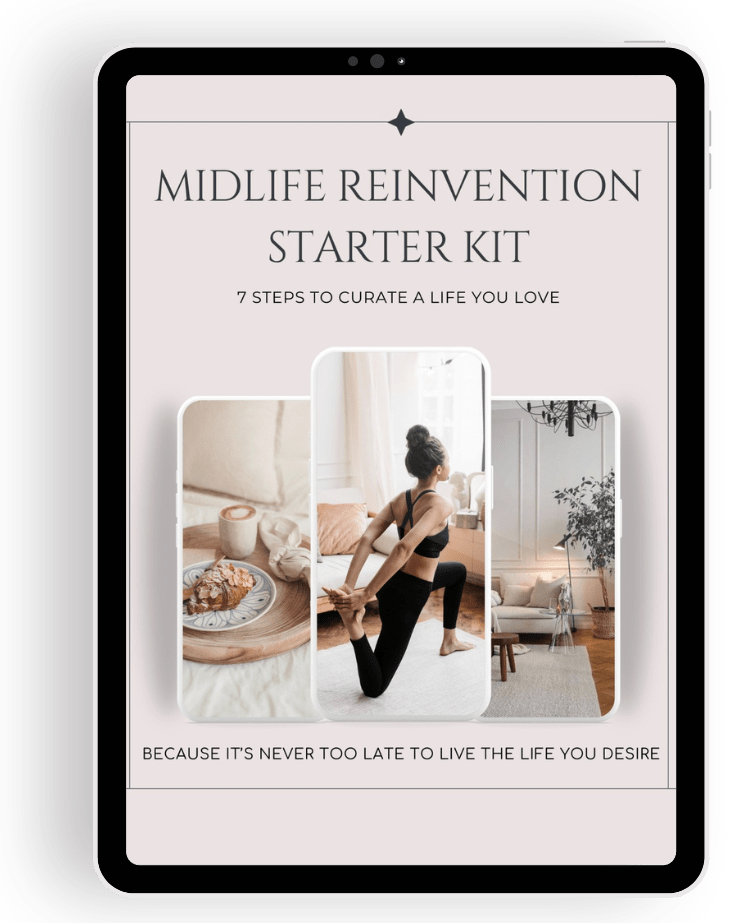Midlife is a time of transition – physically, emotionally, and hormonally. As we navigate perimenopause, menopause, and beyond, our bodies change, and so do our fitness needs. The workout routines that worked in our 30s may no longer feel effective (or enjoyable). However staying active is non-negotiable for maintaining strength, energy, and overall well-being.
The key? A sustainable fitness routine – one that works with your body, not against it. In this guide, you’ll learn how to create a fitness plan that is realistic, effective, and enjoyable, so you can stay strong, healthy, and vibrant for years to come.

Step 1: Shift Your Mindset – Fitness as Self-Care, Not Punishment
Many women associate fitness with weight loss or “fixing” their bodies. But true fitness is about feeling strong, capable, and energised – not shrinking yourself.
Journaling Prompt:
- How do I currently feel about exercise? Is it something I enjoy or something I feel pressured to do?
- What would my ideal fitness routine look like if I removed guilt and external expectations?
Action Step:
Reframe fitness as self-care rather than a chore. Instead of thinking, “I have to work out,” try, “I get to move my body in a way that makes me feel amazing.”

Step 2: Prioritise Strength Training for Long-Term Health
Strength training is the most important type of exercise for midlife women. It:
- ✅ Preserves muscle mass (which naturally declines with age)
- ✅ Boosts metabolism and fat loss
- ✅ Strengthens bones, reducing the risk of osteoporosis
- ✅ Improves hormonal balance and energy levels
How to Incorporate Strength Training:
- Start with 2-3 sessions per week (focus on full-body movements)
- Use weights that challenge you (6-8 reps, the last 2 reps should be difficult)
- Include compound movements (squats, lunges, deadlifts, push-ups, rows)
- Allow for recovery (muscles grow when you rest)
Journaling Prompt:
- What are my biggest barriers to strength training?
- How can I make lifting weights feel less intimidating or more enjoyable?
Action Step:
Choose 3-4 strength exercises to start with and commit to two sessions per week. Increase as you feel stronger.

Step 3: Make Movement a Daily Habit
Consistency is more important than intensity. A sustainable fitness routine includes movement every day, not just structured workouts.
Daily Movement Ideas:
- Walking: One of the best forms of movement for hormone balance and stress reduction
- Yoga & Pilates: Great for mobility, flexibility, and core strength
- Functional movement: Gardening, dancing, housework—everything counts!
Journaling Prompt:
- What forms of movement feel good to me?
- How can I incorporate more movement into my daily routine naturally?
Action Step:
Set a realistic movement goal – e.g., a 20-minute daily walk or stretching in the morning.

Step 4: Support Your Workouts with the Right Nutrition
Midlife fitness isn’t just about exercise – what you eat plays a crucial role in your strength, energy, and recovery.
Nutrition Guidelines for Midlife Women:
- 🥩 Prioritise Protein: Aim for 1.5g per lb of body weight daily (lean meats, eggs, fish, cottage cheese)
- 🥑 Healthy Fats: Support hormones with avocados, nuts, olive oil, and salmon
- 🥗 Colourful Veggies: Fill your plate with antioxidants to fight inflammation
- 🥔 Smart Carbs: Choose whole grains, sweet potatoes, and quinoa for energy
- 💧 Hydration: Drink at least 2-3 litres of water per day

Journaling Prompt:
- What changes can I make to my nutrition that will support my energy levels and workouts?
Action Step:
Plan your meals for the week, focusing on protein, healthy fats, and fibre-rich carbs to fuel your body.
Step 5: Create a Workout Schedule That Works for YOU
The key to long-term consistency is to build fitness into your lifestyle rather than forcing unrealistic goals.
Example Weekly Workout Plan:
- Monday – Strength Training (Full Body)
- Tuesday – 30-minute Walk + Yoga
- Wednesday – Strength Training (Upper Body)
- Thursday – Rest / Light Mobility Work
- Friday – Strength Training (Lower Body)
- Saturday – Long Walk or Fun Activity (Dancing, Hiking, Pilates)
- Sunday – Full Rest or Gentle Stretching
Journaling Prompt:
- What times of the day do I feel most energised to work out?
- What obstacles stop me from exercising, and how can I overcome them?
Action Step:
Create a weekly workout plan based on your energy levels and lifestyle. Adjust as needed, but commit to showing up for yourself.

Step 6: Prioritise Recovery & Listen to Your Body
Midlife fitness is about balance – pushing yourself when needed, but also allowing time for rest and recovery.
Recovery Essentials:
- Sleep: Aim for 7-9 hours per night
- Sauna / Cold Therapy: Supports muscle recovery and reduces inflammation
- Stretching & Mobility: Keep joints and muscles supple
- Rest Days: Essential for muscle growth and hormone balance
Journaling Prompt:
- How do I currently treat my body when I feel tired or sore?
- How can I support my recovery more effectively?
Action Step:
Schedule at least one full rest day per week and prioritise sleep quality.

Client Case Study: How Lisa Transformed Her Midlife Fitness & Found Her Strength
Meet Lisa: A 52-Year-Old Woman Struggling with Energy & Confidence
Lisa had always been active in her younger years, but by the time she hit her 50s, things felt… different. She had gained weight despite eating “healthy,” her energy levels were unpredictable, and the workouts she once loved now left her feeling exhausted instead of energised. Strength training felt intimidating, her joints ached after cardio sessions, and no matter what she tried, she couldn’t find a routine that actually worked for her changing body.
“I felt like my body was betraying me,” Lisa admitted. “Everything I used to do stopped working, and I didn’t know how to move forward. I just wanted to feel strong again.”
Step 1: Reframing Fitness as Self-Care, Not Punishment
Like many women, Lisa had spent years associating exercise with weight loss rather than well-being. Together, we worked on shifting her mindset – her goal became to feel strong, energised, and confident, rather than chasing an unrealistic number on the scale.
📝 Lisa’s Mindset Shift:
- ✅ Focus on how she feels rather than how she looks
- ✅ Celebrate strength & energy instead of weight loss
- ✅ Ditch the guilt – movement should feel empowering, not exhausting
👉 Lisa’s Action Step: Instead of forcing herself into workouts she hated, Lisa started experimenting with movement that felt good. She replaced punishing HIIT workouts with strength training, Pilates, and daily walks, allowing her body to move in a way that felt nourishing, not depleting.
Step 2: Introducing Strength Training & Daily Movement
At first, Lisa was hesitant about lifting weights. She worried about “getting bulky” and felt intimidated by the idea of working with dumbbells. But once she learned that strength training was the key to protecting her muscles, bones, and metabolism, she committed to two 30-minute strength sessions per week.
💪 Lisa’s Strength Training Plan:
- Monday & Thursday: Full-body strength training (squats, deadlifts, push-ups, and rows)
- Daily Walks: 20-30 minutes outdoors for hormone balance & stress relief
- Sunday: Restorative yoga for flexibility & relaxation
Within six weeks, Lisa noticed a huge difference – her posture improved, she felt stronger in her daily life, and her energy levels skyrocketed. “I can actually carry my shopping bags without struggling, and I don’t wake up with aching joints anymore,” she said.
Step 3: Fueling Her Body with the Right Nutrition
Lisa had always eaten what she thought was “healthy,” but after tracking her meals, we discovered she was not getting enough protein to support her muscle recovery and energy.
Lisa’s Nutrition Changes:
- ✅ Increased protein intake (lean meats, eggs, Greek yoghurt)
- ✅ Focused on healthy fats (avocado, olive oil, nuts) to support her hormones
- ✅ Ate more whole foods & reduced processed sugar for stable energy
Within three months, Lisa felt stronger, leaner, and more in control of her body than she had in years.
Step 4: Prioritising Recovery & Listening to Her Body
One of Lisa’s biggest breakthroughs was learning to listen to her body. Instead of pushing through exhaustion, she learned to balance movement with rest and recovery.
🌿 Lisa’s Recovery Routine:
- Prioritised sleep (in bed by 10:30 pm, aiming for 7-8 hours)
- Added sauna sessions & stretching to reduce muscle soreness
- Embraced rest days without guilt
“I used to think I had to work out harder to get results. Now I realise that rest is just as important,” she said.
Lisa’s Midlife Fitness Transformation: The Results
✅ Went from exhausted & overwhelmed → to feeling energised & confident
✅ Replaced restrictive dieting → with balanced, nourishing meals
✅ Stopped dreading workouts → and found a routine she loves
✅ Built strength & resilience instead of focusing on weight loss
💬 Lisa’s Words of Wisdom:
“If I could give any advice to other midlife women, it would be this: stop punishing yourself. Strength training, daily movement, and nourishing your body will change everything – but it has to come from a place of love, not self-criticism. I feel stronger at 52 than I did at 35, and that’s a gift I wouldn’t trade for anything.”
Your Next Step: Take Inspired Action!
Lisa’s story is proof that you CAN feel strong, fit, and fabulous in midlife – you just need a plan that works with your body, not against it.
✨ Your Action Steps Today:
- ✅ Reframe your fitness mindset – make it about strength & self-care, not weight loss
- ✅ Start strength training – even just 2x per week will transform your body
- ✅ Move daily – walk, stretch, and find joy in movement
- ✅ Fuel your body properly – protein, healthy fats & whole foods
- ✅ Prioritise recovery – rest is just as important as workouts
You deserve to feel amazing in your body – strong, confident, and full of life. Start today, and your future self will thank you.
Final Thoughts: Make It Fun, Make It Yours!
The best fitness routine is the one you enjoy and can stick to long-term. It’s not about perfection – it’s about progress.
Key Takeaways:
- ✔ Strength training is the foundation for midlife fitness
- ✔ Daily movement matters more than intense workouts
- ✔ Proper nutrition & recovery support your results
- ✔ Listen to your body and adjust as needed
- ✔ Enjoy the process – fitness should feel empowering, not exhausting
Your Next Steps:
- ✅ Write down your WHY: Why do you want to stay fit & strong?
- ✅ Plan your workouts for the next week
- ✅ Commit to daily movement – even if it’s just 10 minutes
- ✅ Celebrate small wins – progress is progress!
Midlife fitness is a gift to yourself. Prioritise your health, move with love, and embrace the journey ahead. You deserve to feel strong, radiant, and fabulous – at every age.
👉 If you need more guidance, schedule your session below! ⬇️
DISCLAIMER
I am not a health professional or medical practitioner. I am a certified Menopause Wellness Coach, and the information provided here is intended for educational and informational purposes only. It should not be taken as medical advice, diagnosis, or treatment. For any health-related concerns or queries, please consult your GP or a qualified healthcare provider. Always seek the advice of a medical professional before making any changes to your healthcare routine or starting new treatments.

Feel free to sign up to my Friday Morning Love Note HERE! This isn’t just a newsletter - it’s your invitation to pause, reflect, and realign with you. Every week, we’ll journey together to uncover the small, meaningful shifts that will help you design a life that feels uniquely and beautifully yours. Each week, I’ll deliver fresh intentions, uplifting tips, and simple shifts to inspire purposeful, creative living.





